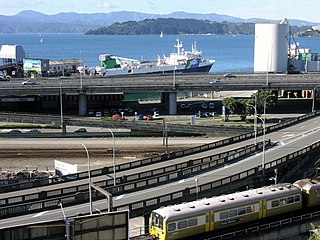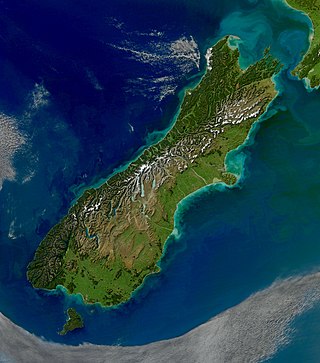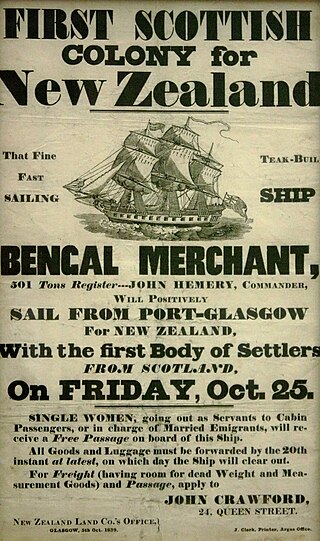Related Research Articles

The demographics of New Zealand encompass the gender, ethnic, religious, geographic, and economic backgrounds of the 5.3 million people living in New Zealand. New Zealanders predominantly live in urban areas on the North Island. The five largest cities are Auckland, Wellington, Christchurch, Hamilton, and Tauranga. Few New Zealanders live on New Zealand's smaller islands. Waiheke Island is easily the most populated smaller island with 9,140 residents, while Great Barrier Island, the Chatham and Pitt Islands, and Stewart Island each have populations below 1,000. New Zealand is part of a realm and most people born in the realm's external territories of Tokelau, the Ross Dependency, the Cook Islands and Niue are entitled to New Zealand passports.

Transport in New Zealand has always faced many challenges, given the country's mountainous topography and a relatively small population, which is located mostly near its long coastline. Before Europeans arrived, Māori either walked or used watercraft on rivers and along the coasts. European shipping and railways revolutionised the transport of goods and people, before themselves being overtaken by road and air transport, which are now the dominant forms. Bulk freight still continues to be transported by coastal shipping and by rail, and there are attempts to (re)introduce public transport as a major transport mode in the larger population centres.

The North Island is one of the two main islands of New Zealand, separated from the larger but less populous South Island by Cook Strait. With an area of 113,729 km2 (43,911 sq mi), it is the world's 14th-largest island, constituting 43% of New Zealand's land area. It has a population of 4,077,800, which is 76% of New Zealand's residents, making it the most populous island in Polynesia and the 28th-most-populous island in the world.

The South Island is the largest of the three major islands of New Zealand in surface area, the others being the smaller but more populous North Island and sparsely populated Stewart Island. It is bordered to the north by Cook Strait, to the west by the Tasman Sea, to the south by the Foveaux Strait and Southern Ocean, and to the east by the Pacific Ocean. The South Island covers 150,437 square kilometres (58,084 sq mi), making it the world's 12th-largest island, constituting 56% of New Zealand's land area. At low altitudes, it has an oceanic climate. The major centres are Christchurch, with a metropolitan population of 521,881, and the smaller Dunedin. The economy relies on agriculture, fishing, tourism, and general manufacturing and services.

The provinces of the Colony of New Zealand existed as a form of sub-national government. Initially established in 1846 when New Zealand was a Crown colony without responsible government, two provinces were first created. Each province had its own legislative council and governor. With the passing of the New Zealand Constitution Act 1852 the provinces were recreated around the six planned settlements or "colonies". By 1873 the number of provinces had increased to nine, but they had become less isolated from each other and demands for centralised government arose. In 1875 the New Zealand Parliament decided to abolish the provincial governments, and they came to an end in November 1876. They were superseded by counties, which were later replaced by territorial authorities.

The southern right whale is a baleen whale, one of three species classified as right whales belonging to the genus Eubalaena. Southern right whales inhabit oceans south of the Equator, between the latitudes of 20° and 60° south. In 2009 the global population was estimated to be approximately 13,600.

Dunedin is the second-largest city in the South Island of New Zealand, and the principal city of the Otago region. Its name comes from Dùn Èideann, the Scottish Gaelic name for Edinburgh, the capital of Scotland. The city has a rich Māori, Scottish, and Chinese heritage.

The New Zealand sea lion, once known as Hooker's sea lion, and as pakake or whakahao (male) and kake (female) in Māori, is a species of sea lion that is endemic to New Zealand and primarily breeds on New Zealand's subantarctic Auckland and Campbell islands, and have in recent years been slowly breeding and recolonising around the coast of New Zealand's South and Stewart islands. The New Zealand sea lion numbers around 12,000 and is one of the world's rarest sea lion species. They are the only species of the genus Phocarctos.

An electorate or electoral district is a geographic constituency used for electing a member (MP) to the New Zealand Parliament. The size of electorates is determined such that all electorates have approximately the same electoral population.
New Zealanders of European descent are mostly of British and Irish ancestry, with significantly smaller percentages of other European ancestries such as Germans, Poles, French, Dutch, Croats and other South Slavs, Greeks, and Scandinavians. European New Zealanders are also known by the Māori-language loanword Pākehā.
The following lists events that happened during 1901 in New Zealand.

Chinese New Zealanders or Sino-New Zealanders are New Zealanders of Chinese ancestry. The largest subset of Asian New Zealanders, many of the Chinese immigrants came from Mainland China, Hong Kong, Taiwan, or other countries that have large populations of Chinese diaspora. Today's Chinese New Zealand group is also composed of diasporic communities from Indonesia, Malaysia, Cambodia, Vietnam and Singapore. As of 2018, Chinese New Zealanders account for 4.9% of the population of New Zealand, and are the largest Asian ethnic group in New Zealand, accounting for 36.3% of Asian New Zealanders.

Migration to New Zealand began only very recently in human history, with Polynesian settlement in New Zealand, previously uninhabited, about 1250 CE to 1280 CE. European migration provided a major influx, especially following the signing of the Treaty of Waitangi in 1840. Subsequent immigrants have come chiefly from the British Isles, but also from continental Europe, the Pacific, the Americas and Asia.

New Zealand has no state religion and freedom of religion has been protected since the signing of the Treaty of Waitangi.
Otahuhu is a former New Zealand parliamentary electorate in the southern suburbs of the city of Auckland, from 1938 to 1963, and then from 1972 to 1984.
American New Zealanders are New Zealand citizens who are of American descent from American-born citizens from the United States. American New Zealanders constitute a small minority of New Zealand's population.

Auckland is a large metropolitan city in the North Island of New Zealand. It has an urban population of about 1,531,400. It is located in the greater Auckland Region, the area governed by Auckland Council, which includes outlying rural areas and the islands of the Hauraki Gulf, and which has a total population of 1,798,300 as of June 2024. It is the most populous city of New Zealand and the fifth largest city in Oceania. While Europeans continue to make up the plurality of Auckland's population, the city became multicultural and cosmopolitan in the late-20th century, with Asians accounting for 34.9% of the city's population in 2023. Auckland has the fourth largest foreign-born population in the world, with 39% of its residents born overseas. With its sizable population of Pasifika New Zealanders, the city is also home to the largest ethnic Polynesian population in the world. The Māori-language name for Auckland is Tāmaki Makaurau, meaning "Tāmaki desired by many", in reference to the desirability of its natural resources and geography.

The climate of New Zealand is varied due to the country's diverse landscape. Most regions of New Zealand belong to the temperate zone with a maritime climate characterised by four distinct seasons. Winters are relatively mild and summers comparatively cool. The main contributing factors are the Pacific Ocean and latitude, although the mountain ranges can cause significant climate variations in locations barely tens of kilometres from each other. Conditions vary from extremely wet on the West Coast of the South Island to almost semi-arid in Central Otago and subtropical in Northland.

Southland is New Zealand's southernmost region. It consists of the southwestern portion of the South Island and includes Stewart Island. Southland is bordered by the culturally similar Otago Region to the north and east, and the West Coast Region in the extreme northwest. The region covers over 3.1 million hectares and spans 3,613 km of coastline. As of June 2023, Southland has a population of 103,900, making it the eleventh-most-populous New Zealand region, and the second-most sparsely populated. Approximately half of the region's population lives in Invercargill, Southland's only city.
Asian New Zealanders are New Zealanders of Asian ancestry . At the 2023 census, 861,573 New Zealanders identifying as being part of the Asian ethnic group, making up 17.3% of New Zealand's population.
References
- ↑ "The Drift to the North", The Press, 17 November 1916, p. 5. Retrieved 6 March 2013.
- ↑ Collins, Simon "Bye Auckland - South's appeal reverses the drift", New Zealand Herald, 25 June 2008. Retrieved 6 March 2013.